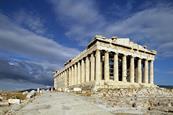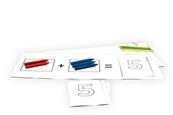Reading: Gaudí
A worksheet with reading and comprehension activities on the life of the architect Gaudí.
Buying and selling
In this role-playing exercise, students practise their reading, listening and speaking skills.
Art gallery
Through this ’spot the difference’ exercise, students will learn key art history terms.
Money and banks
Students examine different types of currency, examining the advantages and disadvantages of bartering for goods, ‘commodity money’ such as gold or salt and ‘fiat money’, such as coins and notes. They read about what services banks offer, why we use them and how they make money. Listening exercises focus on ...
Labour
Focuses on the relationship between employers and workers, how laws of supply and demand operate in the labour market and companies’ need for ‘output’.
Economic systems
The class is introduced to the notion of a ’traditional’ or ’subsistence’ economy, looking at its benefits and drawbacks. Students learn about the market economy, comparing free market economies to an actual street market. Listening exercises focus on pygmy societies, in particular the Mbuti tribe of central Africa, and Adam ...
CLIL History: The Middle Ages
Check out this engaging Question Loop activity associated with the Middle Ages.
Ancient Greece
These resources explore ancient Athens: its organisations, institutions, and what Athenian democracy meant for a burgeoning population in one of the most powerful cities in Greece.
The Roman Empire
Explore the Roman Empire at the time of its greatest expansion and discover how place names connect us to our Roman past
Magic
This lesson plan contains a mathematical magic trick that will help students to practise their speaking skills.
Fractions
In this lesson plan, students match fractions to their pictorial depictions, learn how we work out fractions in English and then practise their skills by doing some sums! A multiple choice fractions quiz (on the theme of ’Jenny’s birthday party’) consolidates what they have learnt. Full teacher’s notes provided.
Sums
A worksheet with activities to make addition, subtraction and multiplication fun while reinforcing the numbers 1-100. Organise the pupils in pairs so that they can discuss and help each other, or set up the activities as a class competition to increase the challenge.
Caught in the act
In this lesson plan, students learn different vocabulary for sporting activities and revise the past continuous.
The history of football hooliganism
A lesson plan about the long history of football hooliganism. Students can read about some of that history in this article on violent fans of the most popular game in the world.
Sports
In this lesson plan, pupils learn about the history of the Olympic games and the origin of popular sports.
Reading: Bar codes
A worksheet by Katherine Stannett with reading and vocabulary activities on the topic of bar codes and how they work.
Tourism: Question Loop Speaking Activity
This fun activity can be used at the beginning of a new topic like ’Tourism’ to introduce new material, or the end to revise material already learned.
The History of Money
Did you know that historians believe the Chinese were the first to use paper money, or that cocoa beans served as currency in ancient Mexico? In this lesson plan, students work in pairs to learn about money, from its earliest forms to the bank cards we use today, including the ...
The History of Money
Did you know that historians believe the Chinese were the first to use paper money, or that cocoa beans served as currency in ancient Mexico? In this lesson plan, students work in pairs to learn about money, from its earliest forms to the bank cards we use today, including the ...
Celebrations: Christmas Cracker Quiz
In this lesson and Christmas quiz, students read about the history of a great British tradition—the Christmas cracker!
Celebrations: Inti Raymi—The festival of the sun
In this lesson, available at two levels, students read texts about the historical festival of Inti Raymi in modern day South America.
Leisure and Tourism
Activities to encourage students to think critically about the impact of tourism: its benefits and disadvantages for countries, and its promises and pitfalls for travellers.
Economic Activities
These worksheets aim to give students an understanding of the types of world economic activities, various types of agriculture and recent issues affecting farming in More Economically Developed Countries (MEDCs) such as the UK.
Farming in Britain
Students match agricultural terms with their definitions before reading about or listening to a British farmer and his son talk about the differences between farming now and in 1950.
The right thing
In this lesson plan, students work in pairs to discuss some of the problems in the developing world and identify possible solutions.
Inventions
Who invented the teabag? When was the paperclip invented? Which invention might you find in a kitchen and a church? This series of activities gets students in teams to find out the answers to these questions while learning all sorts of fascinating facts! A follow-up activity focuses on past tenses ...
Computers: Integrated Skills CLIL Lesson
In this lesson plan, a reading text introduces students to the components of a computer and includes a computer diagram to label, and a listening exercise narrates the history of computing. Useful phrases for when talking about computers, effective reading and writing tips, vocabulary builder exercises and three project ideas ...
Reading: Trevor Bayliss and the wind-up radio
A reading worksheet on the invention of the wind-up radio and its uses. Student exercises focus on comprehension and discussion.
Health and disease
Investigate the science behind diet, fitness, leading a healthy lifestyle and the major diseases of the body.
CLIL Science: Health & Nutrition
Check out this engaging Question Loop activity about health and nutrition.
Places: Teens chat: History
In this lesson plan, teenagers Anna and Ben chat about an internet history quiz and ask each other quiz questions about history. Students listen to the dialogue then complete a gap-fill, label a world map, match sentences to places on the map and complete a vocabulary exercise on words such ...
Sports: Two sides of a sport
What are the positive and negative aspects of sport? In this lesson plan, students listen to an overview of the good and bad aspects of practising a sport. A true/false exercise and gap-fill teaches words such as ‘fan’, ‘train’, ‘cheat’, ‘team’ and ‘winner’. A follow-up debate activity gets students to ...
Animals: Feet Talk!
Feet are fascinating but what are the differences between human feet and bird feet? In this lesson plan, students match feet photos to the names of birds before listening to a description of the feet of woodpeckers, ducks, ostriches and how their feet are suited to their behaviour. A gap-fill ...











